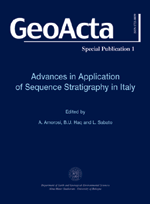GeoActa Special Publication 1
2008


Acquisto online |
GeoActa
an international Journal of Earth Sciences
|
|
Marcello Tropeano, Luigi Spalluto
SDipartimento di Geologia e Geofisica, Universita` di Bari, Campus Universitario, via E. Orabona 4, 70125 Bari, Italy. E-mail: m.tropeano@geo.uniba.it
|
|
|
|
Present-day temperate-type carbonate sedimentation on Apulia shelves (southern Italy)
|
|
|
|
|
|
|
|
PDF (524 KB)
|
Abstract
Summary features of present-day carbonate sedimentation on Apulia shelves (southern Italy) are shown, based upon a synthesis of previously published data. Apulia is a WNW-ESE elongated region, flanked by the sea, and characterised by three large Meso-Cenozoic limestone landmasses; from N to S, the Gargano Promontory, the Murge Plateau, and the Salento Peninsula. Shelves of Apulia are characterised by low-energy waves, a microtidal regime, and surficial thermohaline currents. Moving from the Gargano Promontory to the Salento Peninsula, composition of present-day shallowmarine sediments changes from mixed to carbonate (foramol-type sensu lato). Latitude, climate and sea-water temperature lead to attribute the carbonate production to temperate-type factories. Siliciclastic input from the exposed region to the shelf is low, since few rivers flow in Apulia, supplying small amounts of terrigenous material to their mouths. In spite of this, a longshore muddy-prism, fed by surficial currents and coming from north, contours the Gargano Promontory and occupies middle-shelf settings up to northern Murge. However, according to water circulation, coasts and nearshore zones of Gargano are mainly characterised by rocky bottoms, colonized by an encrusting coralligenous community. To the south (Manfredonia Gulf), rocky coasts pass to depositional paralic settings that are characterised by hybrid sands, whose carbonate components are fed by molluscs and nearshore rhodalgal mounds. In a more southward position, Murge and Salento Adriatic shelves are characterised by rocky coasts that alternate with depositional ones, the latters consisting of molechfor/rhodalgal sand-grained facies. Both types of coasts pass seaward to a rhodalgal nearshore zone characterised by Posidonia meadows. A relict rhodalgal belt is observed along the shelf edge. Shelves that contour the Salento Peninsula are characterised by cliffed coasts toward the Otranto Strait and by an alternation of promontories and beaches toward the Ionian Sea. A rhodalgal nearshore rocky belt develops, while seaward, where the shelf becomes flat, a rhodalgal (relict) - bryomol (modern) belt occurs. Although locally good light penetration and oligotrophic conditions may favour carbonate production, present-day Apulia carbonate factories seem to be unable to produce a sufficient amount of sediments to form ‘‘classic’’ carbonate platform profiles. Apulia shelves show profiles that resemble ramps, but this feature is mainly inherited from the long geological history of the Apulia Region, and present-day carbonate sediments form a thin veneer on top of an antecedent topography.
Keywords: Temperate-type carbonates, Mixed terrigenous-carbonate deposits, Shallow-marine environments, Apulia continental shelves, Southern Italy.
|
|
|


